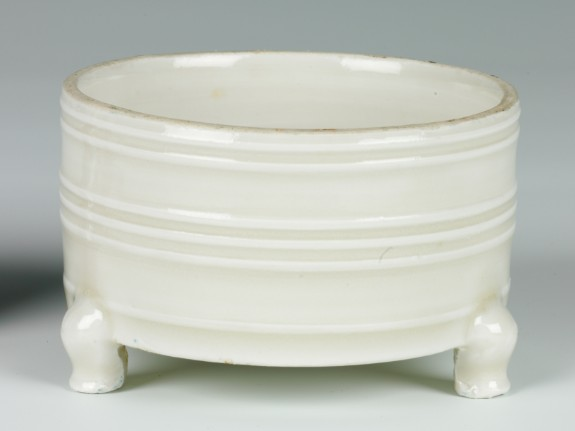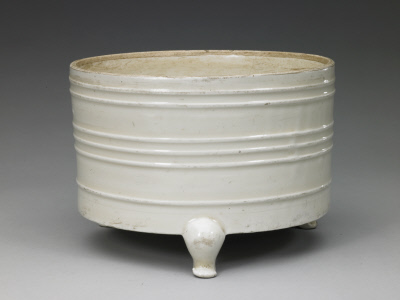White-glazed Three-legged Censer with Round Lines

White-glazed Three-legged Censer with Round Lines
Height: 6.7cm; diameter at the mouth: 10.8cm; diameter at the bottom: 10.4cm
Unearthed from the brick tomb of one couple from the Southern Song Dynasty (1127–1279), Yangjiashan, Changsha city in 1960.
The censer is of globular form and level bottom with three feet. It is of white color and high quality. The whole body is glazed in white, as soft and shiny as ivory, except that the inner-body is exposed at the rim. The smooth body is covered with simple patterns, with 2, 3, 1 round lines at its top, middle and bottom parts of the exterior, which brings rhythmic beauty to appreciators. The censer boasts of simplicity and exquisite craftsmanship. It is of the regular shape and all the body is glazed except the rim. It is produced by employing the upside-down burning method. It is one of the masterpieces from the Ding Kiln.
This Ding Kiln white-glazed three-legged censer with round lines was unearthed from the brick tomb of one couple from Southern Song Dynasty (1127–1279), Yangjiashan, Changsha city.
深入探索
Ding Kiln handled ewer, the middle of the Tang Dynasty (618-907),
Collected by Hebei Provincial Institute of Cultural Relics and Archaeology.

Ding Kiln white-glazed plate with the shape of five petals and inscription of the Chinese character “Guan (from the imperial kiln)”, the late Tang Dynasty,
Collected by Xi’an Museum.

Ding Kiln white-glazed pillow with the shape of a little boy, Northern Song Dynasty,
Collected by the Palace Museum

Ding Kiln white-glazed three-legged incense burner with round lines, Song dynasty,
Collected by the Palace Museum
The function of the three-legged censer with round lines
During the Song Dynasty, burning incense, making tea, flower arrangement and hanging paintings were regarded as the four arts. Besides the traditional functions of getting rid of unpleasant odor, expelling parasite, warding off evil spirits and preventing diseases, burning incense had become an indispensable part of the lifestyle and pleasure during this period. The prevailing practice of burning incense is widely recorded in the poetry and paintings created by the people of the Song Dynasty.
The three-legged censers with round lines were only produced in famous kilns during the Song Dynasty, especial precious ones from the Ru Kiln (in today’s Henan province). The Ru Kiln only produced chinaware for the royal family during the Reign of Emperor Huizong of the Song Dynasty. Its products boasted of superb craftsmanship, which were kept as a secret from the outsiders. Therefore, the number of chinaware from Ru Kiln was very limited. During the reign of Emperor Gaozong of the Southern Song Dynasty, they became rare and very precious. Therefore, three-legged incense burners with round lines were indeed precious objects, which were only available to the emperors and high ranking officials and literati. They could burn incense in it, hold it for pleasure and put it on display.



